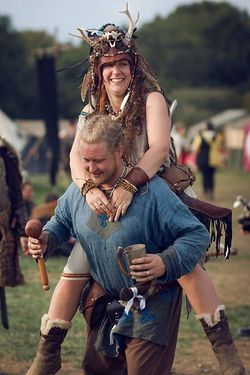Wintermark political leadership
Wintermark remains sparsely populated and the only large town is the former capital at Kalpaheim in Hahnmark. The majority of Winterfolk live in one of the many small settlements, called halls, that dot the land. Each hall is led by a Thane, and although Imperial justice is now dispensed by trained magistrates, the Thane continues to settle disputes that lie outside the law and to provide civic and military leadership.
Traditionally the Kallavesi chose the Wintermark monarch, although they never chose one of their own. This tradition is reflected in many halls, with the Winterfolk looking to the wise and prophetic Kallavesi to choose the most able candidate from amongst the Suaq and the Steinr. There are halls with Kallavesi Thanes, but these are usually the exception and occur when the majority of the inhabitants of the hall are Kallavesi.
The Winterfolk prefer strong, decisive leaders who make bold decisions and stick with them. They have little time for people who vacillate or prevaricate. When the Kallavesi believe that a powerful martial leader is needed they tend to pick a Steinr Thane, if they feel the situation calls for a clever shrewd leader they choose a Suaq. In either case they make an effort to ensure they pick a Thane who the hall can unite behind, the people of Wintermark have little interest in strained loyalties and internal disagreement.
The forerunner of the Senate was the Witan, a grand moot held at Kalpaheim. Here the representatives of each hall met to discuss the business of the nation with the monarch. Today it is a festive gathering held at the start of the year; those who involve themselves in national and Imperial business gather to eat, drink and plan for the year ahead. It is also a time for finding spouses, for seeking out mentors or apprentices, resolving internal conflicts and generally keeping the nation of Wintermark functioning as a strong, healthy whole.
Leading a territory
The symbol of Wintermark is three interlocking rings, representing the belief that the nation is stronger for the influence and inclusion of all three traditions. To preserve this heritage the Winterfolk ensure that they pick a single Senator who follows each tradition. The Steinr select the senator for Hahnmark, the Suaq select the senator for Sermersuaq and the Kallavesi the senator for Kallavesa. When Skarsind was part of Wintermark before being ceded to the Imperial Orcs, the traditions rotated who selected the senator. For example, at the Spring Equinox 379YE it was the turn of the Kallavesa and in 380YE it would have been the turn of the Steinr.
For each territory, every candidate who wishes to be considered sets out a jar bearing their name. Any Winterfolk of the appropriate tradition who wishes to express support may openly drop a single coin into one or more of the jars over the next fifteen minutes. The face value of the coins is irrelevant, but by tradition, wealthy or earnest supporters will try to outdo each other by adding a more valuable coin. At the end of the fifteen minutes, the jar containing the most coins bears the name of the new Senator. The money is given to the stormcrows to be distributed amongst the poorest Winterfolk present.
Although the senators are chosen by followers of a single tradition, in theory it is possible for any of the Winterfolk to stand as a candidate for any territory. In practice it is rare for the Steinr not to choose one of their own, and likewise for the Suaq and the Kallavesi.
The senators for each Imperial territory are re-elected at specific equinoxes and solstices during the year. The senator for Sermersuaq is elected at the Summer Solstice, the senator for Hahnmark is elected at the Autumn Equinox, and the senator for Kallavesa is elected at the Winter Solstice. Prior to the relinquishment of Skarsind, the senator was elected at the Spring equinox.
Incumbent
The current senators of Wintermark are listed below - see the individual territory pages for a full election history for each position.
- Hahnmark - Bronn Dunwolf
- Kallavesa - Rane Shardbearer
- Sermersuaq - Fedelmidd Sydanjaa's Heart Floer
Further Reading
Core Brief
Further Reading
